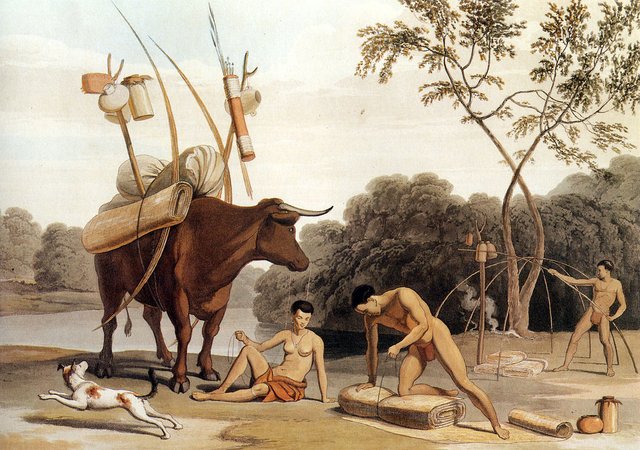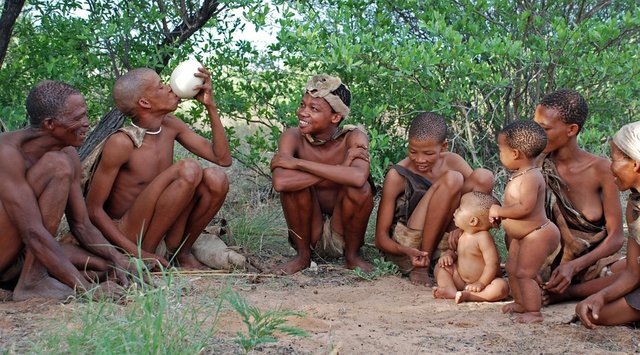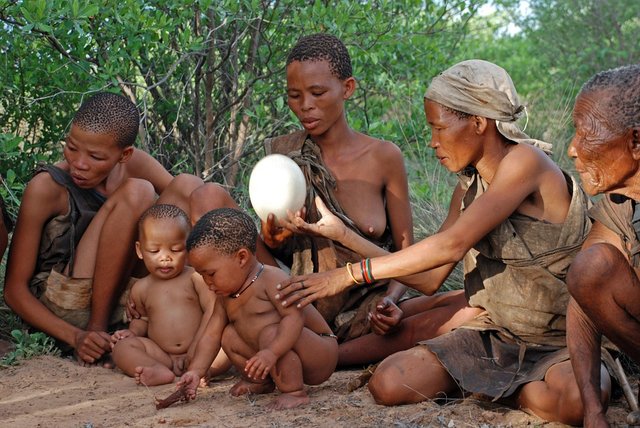The Khoekhoen and the San

Introduction
Linguistic, ethnohistoric and archaeological evidence has been used to map the way in which both the craft of pottery and the raising of domestic livestock spread from Northern Africa. The Khoekhoen descended from the aboriginal hunters of southern Africa; their origins are thought to be in the north, perhaps northern Botswana and adjacent Zimbabwe. Sheep and pottery arrived with the herders at the southern end of Africa shortly after 2000 Before Present (BP). The introduction of livestock and pottery to the western and southern Cape added another element to the subsistence existence of the late Holocene peoples. Archaeological and linguistic data indicate that the herding way of life was adopted rapidly. The rapid spread of the craft of pottery and the widespread evidence of domesticated animals is interpreted as being a result of the expansion of Early Iron Age (EIA) communities and their coming in contact with EIA communities in central and eastern Africa, communities who had mastered the craft of pottery and who had domesticated both sheep and cattle. Sheep (Ovis aries), as well as domesticated dogs (Canis familiaris), cattle (Bos taurus) and, much later goats ( Capra hirus), were husbanded by nomadic groups who are generally referred to as Khoekhoen.
The Khoekhoe herders:
The Khoekhoe and the San

Image: Courtesy of Pixabay
The San and the Khoekhoen share the same ancient genetic heritage. The Khoekhoen called themselves "the real people" to distinguish themselves from other groups such as the San (Soaqua or Sonqua). Although there are biological and linguistic similarities between them, the social and economic practices of the herders differ significantly. The transition from hunting to herding requires such changes. The accumulation of wealth in the form of animals resulted in social distinction between herders and a hierarchically structured society. Animals were important not only for food, but also for their use in rituals and ceremonies - and, eventually, because they signified wealth and prestige.
Individuals in herder groups could achieve status and power; this was in contrast to the egalitarian society of hunter - gatherers, in which everyone was (relatively) equal.
However, we need to remember that society then was not static- a wide spectrum of changing economic and social situations prevailed. For example, hunters would sometimes work for herders, thereby acquiring lifestock (and hence status). They could also marry into a herder group or vice versa. Women from hunter - gatherer groups could marry more readily into herder society than a San man, who would have to accumulate cattle to pay the bride price.The loss of livestock by herders frequently resulted in impoverishment and loss of status, and meant at least a temporary return to a hunting and gathering lifestyle until the herders managed to acquire animals again. Having said this, game and gathered foods remained an important part of the subsistence base of herders lives anyway, because domesticated animals were rarely slaughtered for consumption purposes.

Image: Courtesy of Pixabay
It is difficult to distinguish between hunter - gatherer and herder sites, because the former may have acquired stock through theft or herder clientship and, as we have just said, the latter largely relied on hunting and gathering to supplement pastoral resources. Both groups collected shellfish and used other food sources from the sea, and both groups hunted and gathered plant food. The following artefacts, therefore, cannot be used as a means of distinguishing between herder and hunter - gatherer settlements:
- Digging sticks and bored stone weights (used in the procurement of underground bulbs and corms)
- upper and lower grindstones
- bows and arrows
- stone scapers (used in the processing of animal skins)
- twine and netting
- ornaments of ostrich eggshell, bone, ivory and marine shells.
Excavations at sites such as the large open - air Kasteelberg site in the Western Cape indicate that shellfish and marine animals, and in particular seals, formed a major part of people's diet. Seals were important for their meat and skins, and also for the fat which could be mixed with ochre and rubbed onto the body. Ochre is present throughout the excavation.Rocks within the vicinity of the site have numerous grooves in which the ochre was ground. Analysis of residues on the pottery indicates fats of marine mammal origin. The faunal remains of a range of game animals, small carnivores and sheep were also recovered from the site. the stone tool assemblage is dominated by informal tools.
In contrast, the bone points from the site are well - made. The sizes of ostrich eggshell beads from Kasteelberg were found to be relatively large compared with those from small shelter sites. This site was first occupied by sheep herders between 1800 and 1600 years ago. Dates from sites in Northern Namibia (Geduld), and Spoegrivier in Namaqualand, as well as other shelters in the Western Cape of South Africa, support the theory that people who herded animals first appeared between 2000 and 1800 years ago.
Sources for References:
- Wikipedia
- Boonzaier 1996
- Mithchell . P.J 2002
Please follow me !!!!
Congratulations @multicore! You received a personal award!
You can view your badges on your Steem Board and compare to others on the Steem Ranking
Vote for @Steemitboard as a witness to get one more award and increased upvotes!
Downvoting a post can decrease pending rewards and make it less visible. Common reasons:
Submit